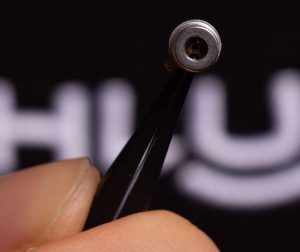
Called Aura, the infra-red devices are built using antimony alloy modified InGaAs.
“The resulting sensors can be operated with APD gains up to 120, enabling even the smallest signals above the noise floor of a connected trans-impedance amplifier to be amplified,” according to the company. “A further benefit is their rapid overload recovery, which means that weaker secondary pulses that closely follow a large pulse can be detected.”
The devices are Aura APD 200 (200µm optical aperture) and Aura APD 80 (80µm aperture).
Typical parameter, according to the company, are 0.98A/W responsivity at 1,550nm, a spectral range of 950 – 1,700nm, and 1.86 excess noise factor at an avalanche gain of 40, or 1.08 at a gain of 10.
At that a gain of 10, APD 200 scores 17fW/√Hz in noise equivalent power, 2.4pF capacitance and 0.7GHz cut-off. The equivalent APD 80 figures are: 11.1fW/√Hz, 0.6pF and 1.8GHz.
Phlux argues that, when used in lidars, these characteristics allow lower-power lasers to be used compared with earlier APDs, reducing system size and weight.
Operation is typically between -55 to -65V (-65V breakdown), and over -40 to +85°C. “Aura APDs operate at up to 85°C without performance degradation,” said Phlux.
Packaging is 3 x 3mm surface-mount, side-emitting surface-mount chip-on-sub-mount (2mm high by 4mm by 2mm+die+bondwires), or 3pin TO-46. Bare die are also available. These are built to MIL-STD-883 for durability, said Phlux.
Use is also foreseen in telecommunications, laser rangefinders, imaging, spectroscopy, gas sensing and optical time domain reflectometers.
Spun-out in 2020 and based in Sheffield UK, Phlux Technology’s intellectual property comes from eight years of research at Sheffield University. It raised £4m a seed funding in December 2022, led by Octopus Ventures.
 Electronics Weekly Electronics Design & Components Tech News
Electronics Weekly Electronics Design & Components Tech News
